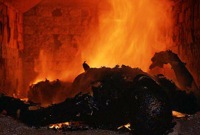Difference between revisions of "Cremation"
m (Text replacement - "http://" to "https://") |
|||
| Line 3: | Line 3: | ||
==Origin== | ==Origin== | ||
[[Latin]] ''crematus'', past participle of ''cremare'' to burn up, cremate | [[Latin]] ''crematus'', past participle of ''cremare'' to burn up, cremate | ||
| − | *[ | + | *[https://en.wikipedia.org/wiki/19th_century 1874] |
==Definition== | ==Definition== | ||
*1: to reduce (as a [[dead]] [[body]]) to ashes by burning | *1: to reduce (as a [[dead]] [[body]]) to ashes by burning | ||
==Description== | ==Description== | ||
| − | '''Cremation''' is the use of high-temperature burning, [[vaporization]], and oxidation to reduce dead [[animal]] bodies, including [[human]] ones, to basic [ | + | '''Cremation''' is the use of high-temperature burning, [[vaporization]], and oxidation to reduce dead [[animal]] bodies, including [[human]] ones, to basic [https://en.wikipedia.org/wiki/Chemical_compound chemical compounds], such as gases and mineral fragments retaining the appearance of dry bone. Cremation may serve as a [[funeral]] or post-funeral [[rite]] that is an alternative to the interment of an intact body in a [https://en.wikipedia.org/wiki/Coffin coffin] or casket. Cremated remains, which do not constitute a [[health]] risk, may be [[buried]] or interred in [[memorial]] sites or cemeteries, or they may be legally retained by relatives and [[dispersed]] in various ways. Cremation is not an alternative to a [[funeral]], but rather an alternative to [[burial]] or other forms of disposal. |
| − | In many countries, cremation is usually done in a crematorium, but other countries prefer [[different]] [[methods]], such as [ | + | In many countries, cremation is usually done in a crematorium, but other countries prefer [[different]] [[methods]], such as [https://en.wikipedia.org/wiki/Pyre open-air cremation] in India and in Nepal. |
| − | Cremation might be preferable for [[environmental]] reasons. [[Burial]] is a known source of certain environmental [[contaminants]], with the coffin itself being the major contaminant, though [ | + | Cremation might be preferable for [[environmental]] reasons. [[Burial]] is a known source of certain environmental [[contaminants]], with the coffin itself being the major contaminant, though [https://en.wikipedia.org/wiki/Natural_burial natural burials] are also possible. Another environmental concern is that [[traditional]] burial takes up a great deal of [[space]]. In a traditional burial, the body is [[buried]] in a casket made from a variety of materials. In the United States, the casket is often placed inside a concrete vault or liner before burial in the ground. While individually this may not take much room, combined with other burials, it can over time cause serious [[space]] concerns. Many [[cemeteries]], particularly in Japan and Europe as well as those in larger [[cities]], have run out of permanent space. In Tokyo, for example, traditional [[burial]] plots are extremely scarce and expensive, and in London, a space crisis led [https://en.wikipedia.org/wiki/Harriet_Harman Harriet Harman] to propose reopening old graves for "double-decker" burials. |
| − | Some [[cities]] in Germany do not have plots for sale, only for lease. When the lease expires the remains are disinterred and a specialist bundles the bones, inscribes the forehead of skull with the [[information]] that was on the headstone, and places the remains in a special crypt.[ | + | Some [[cities]] in Germany do not have plots for sale, only for lease. When the lease expires the remains are disinterred and a specialist bundles the bones, inscribes the forehead of skull with the [[information]] that was on the headstone, and places the remains in a special crypt.[https://en.wikipedia.org/wiki/Cremation] |
==See also== | ==See also== | ||
*'''''[[Burial]]''''' | *'''''[[Burial]]''''' | ||
Latest revision as of 23:45, 12 December 2020
Origin
Latin crematus, past participle of cremare to burn up, cremate
Definition
Description
Cremation is the use of high-temperature burning, vaporization, and oxidation to reduce dead animal bodies, including human ones, to basic chemical compounds, such as gases and mineral fragments retaining the appearance of dry bone. Cremation may serve as a funeral or post-funeral rite that is an alternative to the interment of an intact body in a coffin or casket. Cremated remains, which do not constitute a health risk, may be buried or interred in memorial sites or cemeteries, or they may be legally retained by relatives and dispersed in various ways. Cremation is not an alternative to a funeral, but rather an alternative to burial or other forms of disposal.
In many countries, cremation is usually done in a crematorium, but other countries prefer different methods, such as open-air cremation in India and in Nepal.
Cremation might be preferable for environmental reasons. Burial is a known source of certain environmental contaminants, with the coffin itself being the major contaminant, though natural burials are also possible. Another environmental concern is that traditional burial takes up a great deal of space. In a traditional burial, the body is buried in a casket made from a variety of materials. In the United States, the casket is often placed inside a concrete vault or liner before burial in the ground. While individually this may not take much room, combined with other burials, it can over time cause serious space concerns. Many cemeteries, particularly in Japan and Europe as well as those in larger cities, have run out of permanent space. In Tokyo, for example, traditional burial plots are extremely scarce and expensive, and in London, a space crisis led Harriet Harman to propose reopening old graves for "double-decker" burials.
Some cities in Germany do not have plots for sale, only for lease. When the lease expires the remains are disinterred and a specialist bundles the bones, inscribes the forehead of skull with the information that was on the headstone, and places the remains in a special crypt.[1]
